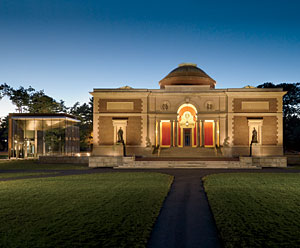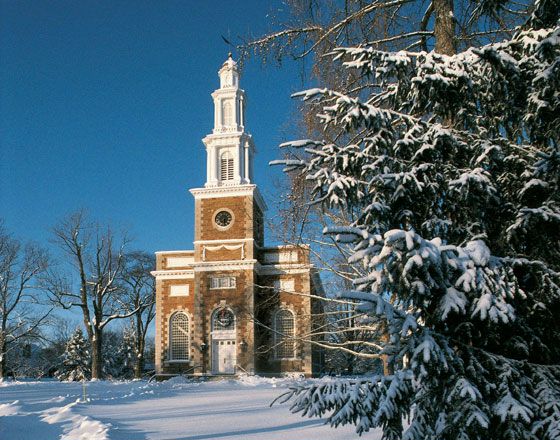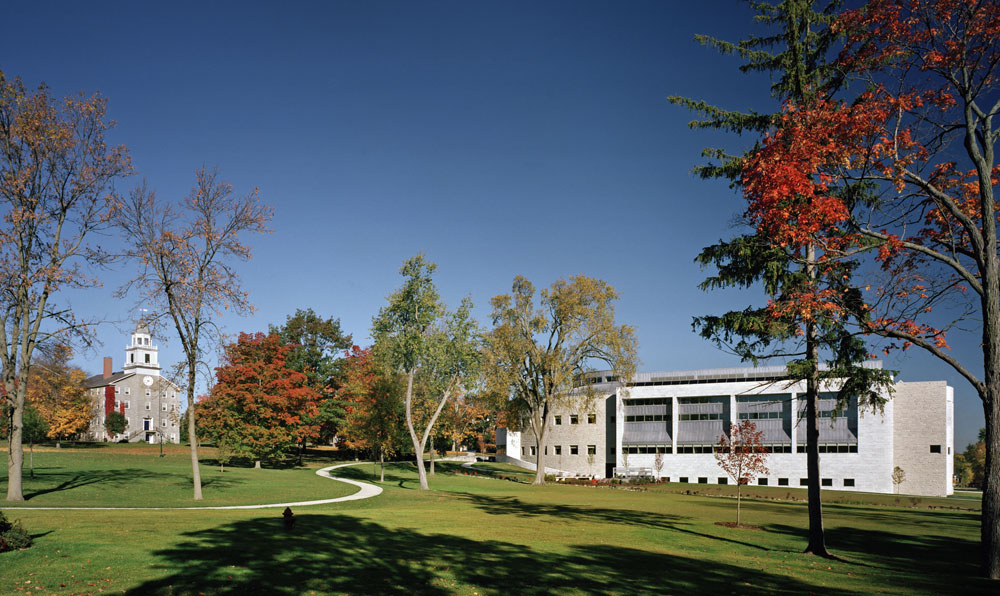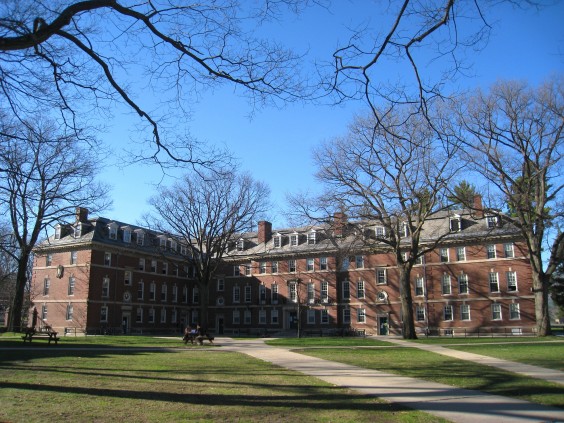Brunswick, MaineMarch 26, 2009As the liberal arts college I have had on my list for the longest, I specifically designed my schedule so that I would have an entire day to fully experience Bowdoin. On this clear, beautiful day, I arrived at the campus at a brisk 8:30 a.m. confronted with the issue of finding the location of Adams Hall, the building of my class sit-in. I jumped out of the car and immediately found a helpful student who walked me all the way to my classroom and on the way engaged in some interesting discussion about the college. Sociology 101 was about as dry as courses come at Bowdoin, but the professor still found ways to impress me. Though she was presenting basic information for the first half of the lecture, the examples she chose to elaborate on and the insightful responses she got back from the students were definitely a plus.
The students in this class also seemed the most like me- mostly driven, intelligent looking people with a MacBook in one hand and a KleenKanteen in the other. Though I spotted some rather grade-grubby note taking and questioning during the class, plenty of students sill found time to laugh or go on Facebook if they got bored during the lecture. While I walked around before and after class, the campus was really thriving with diversity, though in a good way. Really diverse students on campus trace back to the collegeҀs origins as an abolitionist institution and really seemed to blend in to the student body. Also, all of the students looked especially happy and students seemed to have a level of tact that I have not seen at any other school. I especially enjoyed not having to watch the mindless jock conversations, which I think really speak to the caliber of the students.

My tour guide at Bowdoin was a junior from Montreal who really appealed to me as a motivated and well spoken individual who really had her own special flare to offer the college community. This type of student, rather than the stereotypical prep school student from twenty minutes outside Boston, is what I think Bowdoin hopes to ultimately achieve in its entering class, though some sixty percent of students still come from the Northeast.
The tour was definitely the most enjoyable one I have experienced. The tour guide was extremely personable and I felt comfortable asking her any question that popped into my mind. She was from Canada, as much of the student body is so far north, and she seemed to lack the sense of arrogance that graces the students of most prestigious schools. The down to earth justification of why people go to Bowdoin being merit instead of wealth really appealed to me. Though I only got to go inside a few buildings, the campus as a whole really impressed me. Starting with BowdoinҀs famous art museum, this facility really exemplified the caliber of Bowdoin as a school and how the community interacts with it. The fact that student and professional art are shown alongside one another and the museum is still extremely popular and well used really sat well with me. Wandering throughout the rest of the quads, I quickly discovered how tight-knit the campus really is, and I loved every bit of it. From the iconic Hubbard Hall, which houses the social sciences, to the freshman dorms, which had really innovative organizational policies, I loved the prestigious yet homey feel of the campus. Of all of the campuses I have seen so far, only MiddleburyҀs could compare with BowdoinҀs standout architecture, yet only Bates could compare with the unifying and dense flow of the campus buildings into a really cohesive campus feeling. I really experienced a unique fit with BowdoinҀs campus that I cant adequately describe with words. The view of Hubbard hall through the main quadҀs pine clusters really just set the tone that Bowdoin is an old place with a lot of history but still very comfortable and woodsy.


BowdoinҀs people really made the difference for me. With social sciences among the most popular majors, I also saw a huge draw to BowdoinҀs intense academic programs and felt really humbled by the dedication of the faculty I heard about on my visit, all of whom went out of their way every day of the week all of the students. Bowdoin seems like a fit for me because I think I value the academics this school has to offer coupled with the initiative and passion that marks BowdoinҀs diverse student body.

Looking back on my visit, something just stuck with me when I entered a dorm room to see a carpeted hallway painted bright colors with cubby holes for shoes all over the floor. The effect was pure coziness and what looked like an extremely comfortable place to be. On top of the amazing food, I really consider this school to have the best usable facilities of the liberal arts colleges up for consideration.
Adding to this comfort is the proximity of Bowdoin to the town of Brunswick, which it nicely meshes into. Though not in the heart of the town, local sidewalks go past the campus and the community seems like it has a nice blend into the campus. Houses in the immediate area were very nice and victorian, unlike the ones I saw at Bates and Colby, which were lacking a real New England theme. In aerial shots of the campus, you can easily see how easily the campus flows into the nearby town. Brunswick was really fantastic also, with a wonderful view of the bay and a great selection of food and shops.
For the class of 2012, Bowdoin's average SAT score was 1385, with an ACT range of 29-33 (25-75 percentile). The class had an acceptance rate of 19% overall and 30% for Early Decision.
From NewsWeek- 25 New Ivies...Location's high on the list of reasons students flock to Bowdoin. The star attraction: the Atlantic. The school owns 200 acres of beautiful research property on Orr's Island, off the rocky coast of Maine. In winter, students have plenty of space to ski cross-country. Not surprisingly, Bowdoin draws many mountain climbers, kayakers and hikers. Bowdoin's students work hard, but the atmosphere is not as intensely competitive as at comparable schools. The most popular major is government and legal studies, followed by economics, English, history, biology, sociology and environmental science. Bowdoin phased out its fraternities a decade ago, and most students now live on campus. Dorms are small׀about 30 to 50 students per building׀and feel more like apartments. Students praise the food. The school even serves fresh lobster at the first-year banquet. Overlap schools: Williams, Amherst, Brown, Dartmouth and Middlebury.
From Wikipedia:Location:
Bowdoin College, founded in 1794, is a private liberal arts college located in the coastal New England town of Brunswick, Maine. The college enrolls approximately 1,700 students and has been coeducational since 1971. It offers 33 majors and 4 additional minors; the academic year consists of two four-course semesters, and the student-faculty ratio is 9:1. As of 2009, U.S. News and World Report ranks Bowdoin sixth among liberal arts colleges in the United States.
Brunswick is located on the shores of Casco Bay and the Androscoggin River, 12 miles north of Freeport, Maine, 28 miles north of Portland, Maine, and 131 miles north of Boston, Massachusetts. In addition to its Brunswick campus, Bowdoin also operates a 118 acre coastal studies center on Orrs Island in Harpswell, Maine and a 200 acre scientific field station on Kent Island in the Bay of Fundy.
Dining/Popularity:
Bowdoin is particularly well-known for its dining services, which the Princeton Review has ranked first in three of the last four years, including the 2006-2007 school year. Bowdoin also does well in other lifestyle categories; in 2004 it ranked 10th in dorm quality and 14th for quality of life. In April 2008, College Prowler, a publishing company for guidebooks on top colleges and universities in the United States and written by students, named Bowdoin College its "School of the Year" citing excellence in academics, safety and security, housing and dining.
Frat/Social Life:
Since abolishing Greek fraternities in the late 1990s, Bowdoin has switched to a system in which entering students are assigned to one of eight "college houses" correlating with their first-year dormitory. The college houses are physical buildings around campus which host parties and other events throughout the year. Those students who choose not to live in their affiliated house retain their affiliation and are considered members throughout their Bowdoin career.
Academics:
Bowdoin is consistently ranked among the top ten liberal arts colleges in the United States by U.S. News and World Report. In the 2009 edition of the rankings, Bowdoin ranks sixth, behind Williams, Amherst, Swarthmore, Wellesley, and Middlebury. Newsweek described Bowdoin as a "New Ivy," one of a number of elite colleges and universities outside of the Ivy League. As of April 2008, Bowdoin was the first college to be named "School of the Year" by College Prowler.
The Government Department was ranked the top small college political science program in the world by researchers at the London School of Economics in 2003. Government was the most popular major for every graduating class between 2000 and 2004.




























